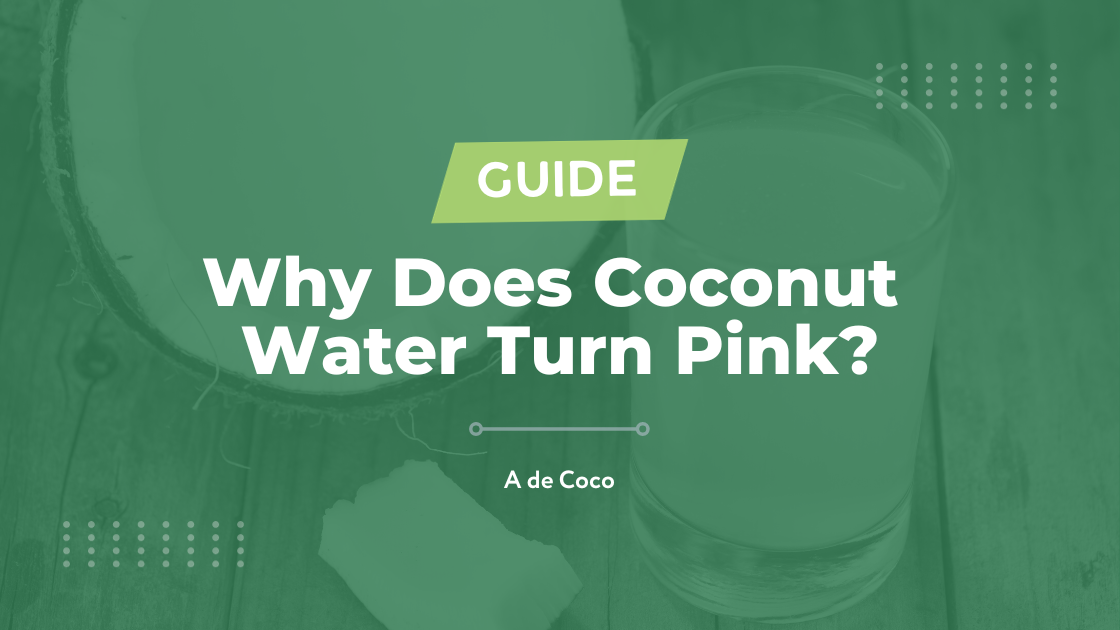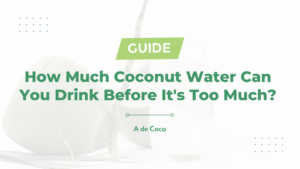Coconut water has become increasingly popular in recent years due to its natural, refreshing taste and impressive health benefits.
Many consumers, however, are often puzzled when they notice a change in its color from clear to a soft shade of pink.
This shift in hue has intrigued some and turned off others, creating a fair bit of confusion.
To allay this uncertainty, it’s time to tap into the science behind this phenomenon.
Understanding why this happens is about more than just aesthetics.
It’s about learning what happens inside a coconut and why it’s entirely natural, safe, and, in fact, beneficial to your health.
Contents
- Why Does Coconut Water Turn Pink?
- Insight on the Science Behind Coconut Water’s Color Change
- The Health Benefits of Pink Coconut Water
- How the Environment and Storage Affect Coconut Water’s Color
- More Than Just a Pretty Color: Nutrition Value in Pink Coconut Water
- Unmasking the Myths: Clear vs Pink Coconut Water
- The Bottom Line
Why Does Coconut Water Turn Pink?
Coconut water can turn pink due to naturally occurring phenols, a type of antioxidant, that react with light. As these phenols interact with the light, they can cause the water to turn pink. It is a natural process and does not indicate any issue with the quality or safety of the coconut water.
Continuing on this topic, it is helpful to delve into other fascinating aspects relating to coconut water.
Knowledge on the nutritional value of this versatile drink, how to select a good coconut, and why the taste of coconut water varies from coconut to coconut will greatly enhance your understanding of this much-loved natural refreshment.
Armed with this information, you will be able to make informed decisions regarding your consumption of coconut water and even impress your friends with your new found knowledge.
Let’s expand on these intriguing details in the sections to follow.
Insight on the Science Behind Coconut Water’s Color Change
Coconut water comes from the center of young, green coconuts.
It’s a popular beverage known for its refreshing taste and health benefits.
One peculiar phenomenon is that coconut water may turn pink when exposed to air.
This surprising color change mystifies and intrigues many people.
So, what’s behind this color change?
The answer lies in a group of compounds called phenolic antioxidants.
The Role of Phenolic Antioxidants
Phenolic antioxidants in coconut water are responsible for the color transformation from clear to pink.
These compounds are naturally present in many fruits and vegetables.
When phenolic antioxidants come into contact with light or air, they can undergo oxidation.
This results in a color shift from clear to pink.
This color change is essentially a reaction of the antioxidants in the coconut water with oxygen in the air.
This oxidation process is completely natural and is demonstrating the presence of phenolic compounds, which perform many functions for health.
For instance, they play a significant role in protecting our bodies from disease.
There is also a link between the degree of pink coloration and the number of antioxidants.
The pinker the coconut water, the higher the concentration of antioxidants.
Environmental and Storage Influences
The environment and storage conditions of coconut water can also influence its color.
Hence, the temperature, humidity, and exposure to light or air can all impact the degree of oxidation in the coconut water.
The color transformation indicates that the coconut water is rich in phenolic antioxidants, beneficial for our health.
The pinker the coconut water, the higher the concentration of antioxidants.
There has been quite a bit of discussion around the safety of drinking pink coconut water.
The color change can be unnerving to some who associate clear liquids with purity and cleanliness.
It’s important to understand that color is not always an indicator of freshness or suitability for consumption.
Phenolic Compounds and Color Change
As mentioned earlier, one of the main reasons for the occasional shift in color of coconut water to pink or red is due to the presence of phenolic compounds.
These compounds are present in a variety of fruits and vegetables and are often linked to a range of health benefits.
Phenolic compounds are highly reactive and, when exposed to certain enzymes and oxygen, can lead to the development of different colors.
Phenolic compounds are often linked to a range of health benefits.
This reaction is not unique to coconut water but is also responsible for the browning of apples or avocados after they’ve been cut open and left exposed to air.
Therefore, the presence of these compounds and the ensuing color change does not make the coconut water harmful nor bettter.
Safety and Expiry
In terms of safety and expiry, the color of coconut water does not necessarily indicate spoilage.
Like any other natural product, coconut water will naturally expire over time and proper storage methods should be used to maintain its freshness.
It’s advisable to consume coconut water within its stated shelf-life and to discard any that has an odd smell or flavor.
Just as the color change to pink doesn’t necessarily indicate danger, remaining clear doesn’t guarantee safety either.
Like any other natural product, coconut water will naturally expire over time and proper storage methods should be used to maintain its freshness.
Coconut water that has been improperly stored, or has exceeded its shelf life, may not change color but can still become unsafe to drink.
Therefore, it’s crucial to review the product labels, adhere to storage directions, and consume in a timely manner, regardless of the color.
The Health Benefits of Pink Coconut Water
Coconut water, in its different shades and variants, has been a popular go-to nutritional beverage, thanks to its refreshing taste and health benefits.
When we talk about pink coconut water, it tends to pique the curiosity of many because of its unique and appealing color.
But, there is a lot more to pink coconut water than just the color.
Rich Source of Antioxidants
Pink coconut water is particularly lauded for its strong antioxidant properties.
What causes this is the presence of phenols in the water, triggered by exposure to light and air.
These antioxidants are known for their ability to counteract harmful free radicals in the body.
This reduces oxidative stress and suppresses inflammation, protecting the body from various ailments such as heart diseases and cancers.
Indeed, the antioxidant power of pink coconut water is a major plus.
So, not only do you get to enjoy a tasty drink, but also benefitting from its antioxidant properties.
This is one reason why many health-conscious individuals opt for pink coconut water as part of their balanced diet.
Loaded with Essential Nutrients
On top of its antioxidant properties, pink coconut water is also a rich source of several essential nutrients.
This includes minerals like potassium, magnesium, sodium, and calcium, all of which are crucial for maintaining optimal bodily functions.
For instance, potassium helps regulate your heart’s electrical activity and maintains your body fluid levels.
Calcium, on the other hand, is essential for strong bones and teeth.
These nutrients not only ensure that your body is functioning at its best, but also promote long-term health.
Pink coconut water is a rich source of several essential nutrients crucial for maintaining optimal bodily functions.
It can even replace electrolyte drinks for many athletes due to its natural composition of essential minerals.
Also, it’s important to say that these benefits can also be found in clear coconut water as well.
How the Environment and Storage Affect Coconut Water’s Color
The environment, particularly temperature and light exposure, plays a significant role in the color change that occurs in coconut water.
The Impact of Temperature
Temperature has a considerable impact on the enzymes that initiate the oxidation process in coconut water.
Typically, coconut water stored at higher temperatures will go through this process more swiftly, causing it to turn pink faster.
Under cold storage conditions, however, the pinkish color change can be noticeably retarded or even prevented.
But it’s important to note that storage temperature doesn’t only affect the color but also the freshness and nutritional value of the coconut water.
Higher storage temperatures can lead to nutrient degradation and microbial growth that can spoil the beverage.
Under cold storage conditions, however, the pinkish color change can be noticeably retarded or even prevented.
This fact informs why most commercially available coconut water is normally refrigerated.
By limiting the activation of the enzymes responsible for the oxidation process, cold storage helps extend the shelf-life of the water while maintaining its clear color and nutrient value.
Light Exposure’s Influence
Another environmental factor affecting coconut water’s color is exposure to light.
Like temperature, light can enhance the activity of the oxidizing enzymes, speeding up the transition to a pink hue.
It is therefore advisable to store coconut water in a dark environment to conserve its pure color, especially when it’s not refrigerated.
This is the reason majority of bottled coconut water is kept in opaque or colored containers, to limit light exposure and thus further slowing the enzymatic oxidation process.
Like temperature, light can enhance the activity of the oxidizing enzymes, speeding up the transition to a pink hue.
This inhibiting effect remains essential not only for aesthetic purposes but also for ensuring the product’s overall quality.
Indeed, while the pink color is not harmful, prolonged light exposure can also lead to nutrient degradation and off-flavor development, affecting the enjoyment of the beverage.
Considering the impacts of temperature and light on the coconut water color, it’s quite clear that how and where the beverage is stored can significantly affect its perceived freshness, quality, and color.
The pink color change is not a sign of bad quality but rather a fascinating manifestation of natural enzymatic processes accentuated by environmental conditions.
Whether you prefer your coconut water clear or pink, understanding these factors will help you better appreciate the dynamics behind one of nature’s most refreshing beverages.
More Than Just a Pretty Color: Nutrition Value in Pink Coconut Water
Beyond the enticing pink hue and the refreshing tropical flavor, pink coconut water presents a wealth of nutritional advantages.
Interestingly, the pink coloration of coconut water is linked directly to its nutritional content.
This suggests that its color may serve as an indicator of its health benefits and nutritional value.
One key attribute of pink coconut water is its phenols content.
Phenols are natural compounds present in plant-based foods.
They are known for their potent anti-oxidative properties and contribute significantly to the health properties of pink coconut water.
Apart from their anti-oxidative properties, phenols also play a role in the process of enzymatic browning or the process that turns the water pink when exposed to air.
Phenols and Antioxidants
When coconut water turns pink, it’s an indication that the phenols are reacting with light, causing them to oxidize.
This reaction dramatically increases the antioxidant levels in the coconut water.
Antioxidants are crucial in our diets as they help to combat free radicals in our bodies.
Free radicals are uncharged molecules that can cause cellular damage if left unchecked.
Hence, pink coconut water, with its heightened antioxidant activity, can be a natural and delicious way to boost our body’s defenses.
Hence, pink coconut water, with its heightened antioxidant activity, can be a natural and delicious way to boost our body’s defenses.
This makes pink coconut water a not only tasty, but also a health beneficial drink.
The higher antioxidant content can result in improved overall health and potentially ward off various diseases.
Minerals and Electrolytes
Besides antioxidants, pink just as clear coconut water is also rich in essential minerals and electrolytes.
It is particularly high in potassium, magnesium, and calcium, minerals that are important for many bodily functions.
These include promoting healthy heart rhythms, bone health, and muscle function.
Consequently, drinking pink coconut water can be a delightful way of supplementing these vital minerals in our daily diet.
This further enhances the health advantages pink coconut water offers.
Consequently, drinking pink coconut water can be a delightful way of supplementing these vital minerals in our daily diet.
Thus, it might be worth to give pink coconut water a try, knowing the valuable nutrition one can gain from it.
Moreover, its natural sweetness also makes it a more desirable option over artificially sweetened drinks.
Unmasking the Myths: Clear vs Pink Coconut Water
Coconut water has taken the health world by storm, celebrated for its hydration abilities and packed with essential vitamins and minerals.
There’s a prevailing myth, however, that the color of your coconut water can reveal the quality and nutritional value it possesses.
Specifically, the dispute between clear and pink coconut water rages on, with consumers questioning whether one is superior to the other.
The Color Debate
First off, it’s crucial to understand that color alone is not a strong enough measure of quality or nutritional substance when it comes to coconut water.
The color of coconut water can vary, largely because it is a natural product.
Coconut water changes from clear to pink due to the presence of phenolic antioxidants.
These antioxidants react with the light and oxygen they are exposed to over time, initiating this color transformation.
This naturally occurring process doesn’t detract from the quality or nutritional value of the product.
The color of coconut water can vary, largely because it is a natural product.
Therefore, vast variation in color doesn’t necessarily reflect the amount of nutrients within the coconut water.
It is important to keep in mind, though, that pink coconut water might contain more antioxidants, since the color change is due to their presence.
Nutritional Composition
Another myth that often circulates is the notion that pink coconut water has a higher nutritional value than clear coconut water.
However, while pink coconut water may contain more phenolic compounds due to the reactions leading to its color change, its overall nutritional composition remains the same.
In other words, whether your coconut water is clear or pink, it still provides almost identical amounts of key nutrients like potassium, calcium, and magnesium.
As such, consumers should not be swayed by color alone when choosing coconut water.
Instead, they should focus on factors like freshness and whether the product contains added sugars or other additives.
Whether your coconut water is clear or pink, it still provides almost identical amounts of key nutrients like potassium, calcium, and magnesium.
Therefore, consumers should make their purchase decisions based on other aspects such as additives and freshness.
Flavor Differences
The taste of coconut water may also be a concern for many consumers.
There’s a belief that pink coconut water tastes sweeter than the clear variety due to its higher antioxidant content.
However, the difference in taste is often minimal and largely subjective.
Some may discern a slight variation in flavor, but the overall sweet and refreshing taste of coconut water remains consistent.
In conclusion, the clear vs pink coconut water debate boils down to a simple truth: color variations in coconut water are natural and do not significantly impact the nutritional value or taste of the beverage.
As a consumer, you can enjoy your coconut water, regardless of its color, knowing that you are benefitting from a hydrating and nutritious drink.
The Bottom Line
There’s a genuine fascination about the varying hues of coconut water, particularly its transformation to a versatile pinkish hue.
This natural color change is attributed to phenols, active compounds that contribute to the antioxidant properties of coconut water.
Contrary to assumptions, pink coconut water is safe to drink and even offers benefits such as increased antioxidant capabilities.
Its color depends on several factors like environmental conditions and storage methods.
Interestingly, this pretty color also enhances nutritional value by providing more antioxidants than clear coconut water.
However, the flavor profile does not significantly differ, making both clear and pink coconut water refreshing and enjoyable.
Ultimately, the process of coconut water turning pink is completely natural and enhances the overall health benefits of this tropical beverage.




